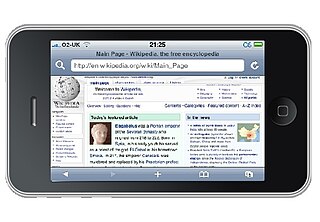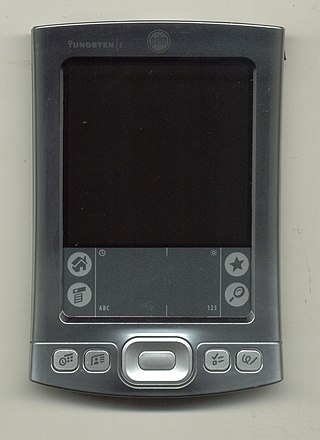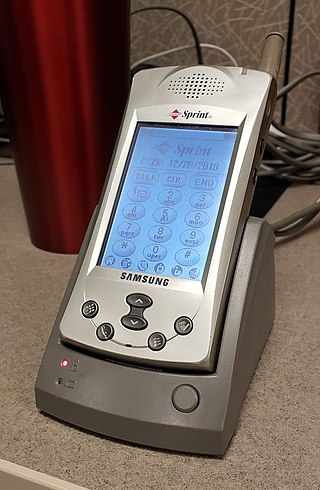Related Research Articles

A personal digital assistant (PDA), also known as a handheld PC, is a variety mobile device which functions as a personal information manager. PDAs have been mostly displaced by the widespread adoption of highly capable smartphones, in particular those based on iOS and Android.

Palm OS was a mobile operating system initially developed by Palm, Inc., for personal digital assistants (PDAs) in 1996. Palm OS was designed for ease of use with a touchscreen-based graphical user interface. It is provided with a suite of basic applications for personal information management. Later versions of the OS have been extended to support smartphones. Several other licensees have manufactured devices powered by Palm OS.

Palm, Inc. was an American company that specialized in manufacturing personal digital assistants (PDAs) and various other electronics. They were the designer of the PalmPilot, the first PDA successfully marketed worldwide, as well as the Treo 600, one of the first smartphones. Palm developed several versions of Palm OS for PDAs and smartphones. The company was also responsible for the first versions of webOS, the first multitasking operating system for smartphones, and enyo.js, a framework for HTML5 apps.

Palm was a line of personal digital assistants (PDAs) and mobile phones developed by California-based Palm, Inc., originally called Palm Computing, Inc. Palm devices are often remembered as "the first wildly popular handheld computers," responsible for ushering in the smartphone era.

A smartphone is a portable computer device that combines mobile telephone and computing functions into one unit. They are distinguished from feature phones by their stronger hardware capabilities and extensive mobile operating systems, which facilitate wider software, internet, and multimedia functionality, alongside core phone functions such as voice calls and text messaging. Smartphones typically contain a number of metal–oxide–semiconductor (MOS) integrated circuit (IC) chips, include various sensors that can be leveraged by pre-included and third-party software, and support wireless communications protocols.
The Samsung SPH-i550 smartphone is the Palm OS-based planned successor to the clamshell style SPH-i500. The SPH-i550 has a 320x320 internal screen and an external OLED display. The camera takes 1 MP stills and can record video. A built-in MP3 player is controlled by external buttons without having to open the phone.

A mobile browser is a web browser designed for use on a mobile device such as a mobile phone or PDA. Mobile browsers are optimized to display Web content most effectively on small screens on portable devices. Mobile browser software must be small and efficient to accommodate the low memory capacity and low-bandwidth of wireless handheld devices. Traditional smaller feature phones use stripped-down mobile web browsers; however, most current smartphones have full-fledged browsers that can handle the latest web technologies, such as CSS 3, JavaScript, and Ajax.

The Tungsten series was Palm, Inc.'s line of business-class Palm OS-based PDAs.
Windows Mobile is a discontinued family of mobile operating systems developed by Microsoft for smartphones and personal digital assistants.

Blazer was a web browser available for Palm handhelds running Palm OS 3.1 or higher.
A mobile operating system is an operating system for mobile phones, tablets, smartwatches, smartglasses, or other non-laptop personal mobile computing devices. While computers such as typical laptops are "mobile", the operating systems used on them are generally not considered mobile ones, as they were originally designed for desktop computers that historically did not have or need specific mobile features. This line distinguishing mobile and other forms has become blurred in recent years, due to the fact that newer devices have become smaller and more mobile unlike hardware of the past. Key notabilities blurring this line are the introduction of tablet computers and light-weight laptops and the hybridization of the two in 2-in-1 PCs.

The Samsung Instinct (SPH-M800) was an Internet-enabled smartphone designed and marketed by Samsung Mobile. It uses a Haptic touchscreen interface, and three touchscreen buttons. The Instinct, in addition to being a mobile phone, also functions as a camera phone, portable media player, text messenger, and a complete web browser and e-mail client. The email client allows for access to only the main inbox of any associated account – not to any subfolder. The folders for "drafts", "sent", "deleted", and "outbox" represent only messages originating from the phone.
Handspring, Inc. was an American electronics company founded in 1998 by the founders of Palm, Inc. after becoming dissatisfied with the company's direction under new owner 3Com. The company developed Palm OS–based Visor- and Treo-branded personal digital assistants. In 2003, the company merged with Palm, Inc.'s hardware division.
The form factor of a mobile phone is its size, shape, and style, as well as the layout and position of its major components.

The Samsung Moment, known as SPH-M900, is a smartphone manufactured by Samsung that uses the open source Android operating system.

The HTC Evo 4G is a smartphone developed by HTC Corporation and marketed as Sprint's flagship Android smartphone, running on its WiMAX network. The smartphone was launched on June 4, 2010. It was the first 4G enabled smartphone released in the United States.

The Samsung SPH-i300 was an early Palm OS-based smartphone manufactured by Samsung. It was released around 2001. It was marketed in the United States for use on Sprint's mobile phone network. It was the first "PDA phone" in the US with a color screen.

The Fossil Wrist PDA is a smartwatch that runs Palm OS. The newer incarnation, which does not include Palm OS, is called the Fossil WristNet watch.
The HTC Evo Shift 4G is a smartphone developed by HTC Corporation and marketed as the concurrent/sequel to Sprint's flagship Android smartphone, running on its 4G WiMAX network. The smartphone launched on January 9, 2011.
References
- ↑ "Samsung unleashes PalmOS smartphone, the SPH-i500", Mobile Burn, November 13, 2002 Archived February 8, 2006, at the Wayback Machine
- ↑ Samsung SPH-i500, CNET, 8/21/03
- ↑ Brown, Bruce. Samsung SPH-i500, PC Mag
- ↑ Gade, Lisa, http://www.mobiletechreview.com/samsung_i500.htm August 26, 2003